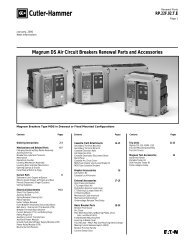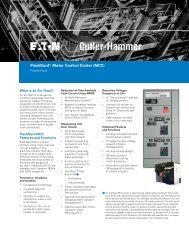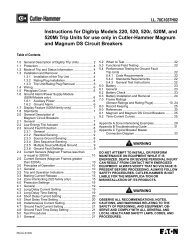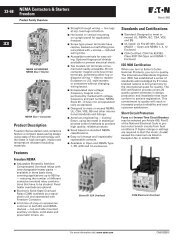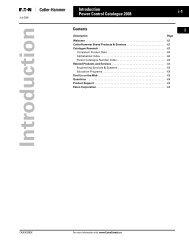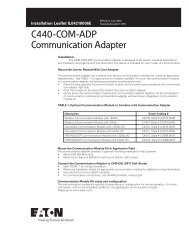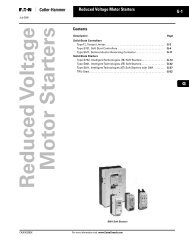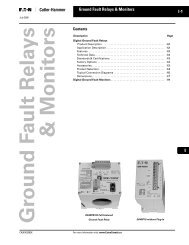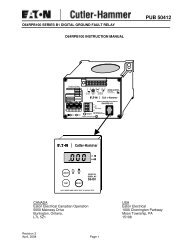M-Maxâ„¢ Series Adjustable Frequency Drive - Eaton Corporation
M-Maxâ„¢ Series Adjustable Frequency Drive - Eaton Corporation
M-Maxâ„¢ Series Adjustable Frequency Drive - Eaton Corporation
You also want an ePaper? Increase the reach of your titles
YUMPU automatically turns print PDFs into web optimized ePapers that Google loves.
Engineering<br />
Motor and Circuit Type<br />
The motor’s stator winding can be connected in a star or<br />
delta configuration, in accordance with the rated operational<br />
data on the nameplate.<br />
Example of a Motor Ratings Plate<br />
230 /400 V 3.5/2A<br />
S1 0.75 kW cos 0.79<br />
1430 RPM 50 Hz<br />
Star and Delta Circuit Types<br />
U1 V1 W1<br />
W2 U2 V2<br />
U1 V1 W1<br />
W2 U2 V2<br />
The three-phase motor with the rating plate based on the<br />
figure shown above, can be run in a star or delta connection.<br />
The operational characteristic curve is determined by the<br />
ratio of motor voltage and motor frequency, in this case.<br />
87-Hz Characteristic Curve<br />
In the delta circuit with 400V and 87 Hz, the motor shown in<br />
the figure above was released with three times-fold output<br />
(~1.3 kW).<br />
Notes<br />
� Star connection: 400V, 50 Hz.<br />
� Delta connection: 230V, 50 Hz.<br />
� Delta connection: 400V, 87 Hz.<br />
� Note the permitted limit values of the motor.<br />
24 M-Max <strong>Series</strong> <strong>Adjustable</strong> <strong>Frequency</strong> <strong>Drive</strong><br />
Because of the higher thermal loading, using only the next<br />
higher motor output according to the list (1.1 kW) is<br />
recommended. The motor (in this example) therefore still has<br />
1.47-fold higher output compared with the listed output<br />
(0.75 kW).<br />
With the 87-Hz characteristic curve, the motor also works in<br />
the range from 50 to 87 Hz with an unattenuated field. The<br />
pull-out torque remains at the same level as in input<br />
operation with 50 Hz.<br />
The heat class of the motor must be at least F in 87-Hz<br />
operation.<br />
V/Hz-Characteristic Curve<br />
U 2 (V)<br />
400<br />
230<br />
0<br />
50<br />
The following table shows the allocation of possible<br />
frequency inverters depending on the input voltage and the<br />
type of circuit.<br />
Assignment of <strong>Frequency</strong> Inverters to Example Motor Circuit (See Figure Above)<br />
<strong>Frequency</strong> Inverters MMX12AA3D7_ MMX32AA3D7_ MMX34AA2D4_ MMX34AA4D3_<br />
Rated operational current 3.7A 3.7A 2.4A 4.3A<br />
Input voltage 1 AC 230V 1 AC 230V 3 AC 400V 3 AC 400V<br />
Motor circuit Delta Delta Star Delta<br />
V/Hz-characteristic curve<br />
� � � �<br />
Motor current 3.5A 3.5A 2.0A 3.5A<br />
Motor voltage 3 AC 0–230V 3 AC 0–230V 3 AC 0–400V 3 AC 0–230V<br />
Motor speed 1430 min–1<br />
1430 min–1<br />
1430 min–1<br />
2474 min–1<br />
�<br />
Motor frequency 50 Hz 50 Hz 50 Hz 87 Hz �<br />
MN04020003E—April 2011 www.eaton.com<br />
87<br />
f max<br />
f (Hz)




